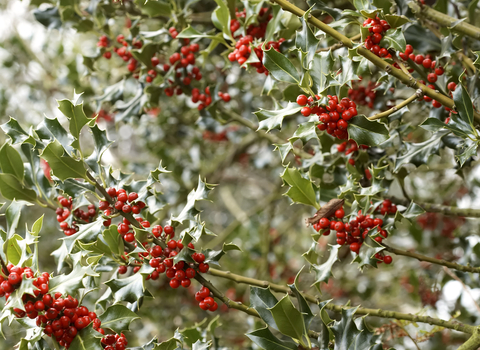Location
Know before you go
Dogs
Dogs on leads between 1st March and 31st July due to ground nesting birds such as skylarks and pipits. Grazing animals also sometimes present.
When to visit
Opening times
Open at all timesBest time to visit
All year roundAbout the reserve
The main footpath along the Stiperstones ridge goes straight down the side of The Hollies nature reserve. Few people step off the track to explore this ancient, scattered grove of hollies, but those that do soon fall under its spell.
The trees are extraordinary characters, some of them three or four centuries old. Wizened and creaking with age, their trunks are dry as driftwood and riddled with beetle burrows. Stubborn beings, they are astonishing in their power of renewal, youth breaking out in the most unlikely specimens. A skeleton of a tree sprouts a juicy branch of shiny, prickled leaves; one has a hole in its trunk, a window with a view; another is split in two at its base.
Often here, you find a holly and a rowan growing right next to each other and rowans rooted inside hollies. This curious phenomenon occurs because redwings, fieldfares and other wintering thrushes like to eat rowan berries, then perch in holly trees where their droppings fall, complete with seed, which germinates from a crack in the tree’s bark. These ‘cuckoo’ trees have, in many instances, grown stronger than their host, splitting the holly in half as their roots grew down.
There are younger, bushier trees too; clusters of berries twinkling among their dense crowns of dark, shiny leaves. Sheep like these best, sheltering under them in winter, enjoying their deep shade in summer. Livestock have unwittingly played a leading role in keeping these trees alive over centuries. During the 19th century, miners working in the Snailbeach lead mines lived up here in draughty cottages, keeping a few sheep and cattle to supplement their earnings. Holly leaves, rich in calories and nutrients, provided the perfect winter fodder. The prickle-less leaves above the browsing line, are quite palatable to a hungry cow.
This usefulness protected the trees from being chopped up for firewood, or felled for bobbin-making, teapot lid knobs, or the handles of horse-whip handles; the fate of so many of England’s holly groves. Meanwhile, regular lopping of holly branches invigorated the trees, prolonged their lives and shaped their characters.
No one lives on the ridge anymore, but the livestock remain. Their influence in recent decades has been less benign, the result of EU Common Agricultural Policy (CAP) that encouraged farmers to keep huge numbers of sheep. Approximately a third of the hollies have suffered browsing damage: tender young leaves shooting out from the lower parts of the tree have been constantly nibbled off, nipping the trees’ renewal in the bud. Sheep and cattle have also gnawed the bark and rubbed their itchy backs against the trees, wearing away the protective covering and exposing them to disease.
Getting to The Hollies
From Shrewsbury follow the A488 through Minsterley. Turn left to Snailbeach. At the brow of the hill is a car park next to the village hall. Leave your car here and walk up the road above left, past the old leadmine buildings and up a steep hill. At the top, take a track to your left which leads you to Lord's Hill chapel. Go through the gate, following the right fork of the track. The Hollies is on your left.
Contact us
Location map
Become a member and support our work
The vital work we do for nature depends on the support of people who care about the future of Shropshire's wildlife and wild places.

